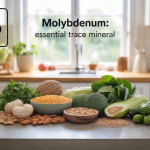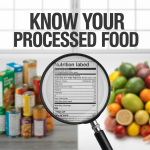Premenstrual syndrome affects up to 75% of menstruating women, causing everything from mood swings and bloating to intense cravings and fatigue. If you’re tired of letting PMS control your monthly routine, the right nutritional approaches to relieve PMS symptoms can make a real difference in how you feel.
This guide is for women who want practical, science-backed strategies to ease their PMS symptoms through targeted nutrition and lifestyle changes. Whether you experience mild discomfort or severe symptoms that disrupt your daily life, these approaches can help you take back control.
We’ll explore how specific nutrients directly impact your hormonal balance during PMS, including the essential vitamins and minerals that research shows can reduce symptom severity. You’ll also discover which anti-inflammatory foods can combat PMS discomfort naturally, plus learn about meal timing strategies that work with your body’s changing needs throughout your cycle.
Understanding How Nutrition Impacts Hormonal Balance During PMS
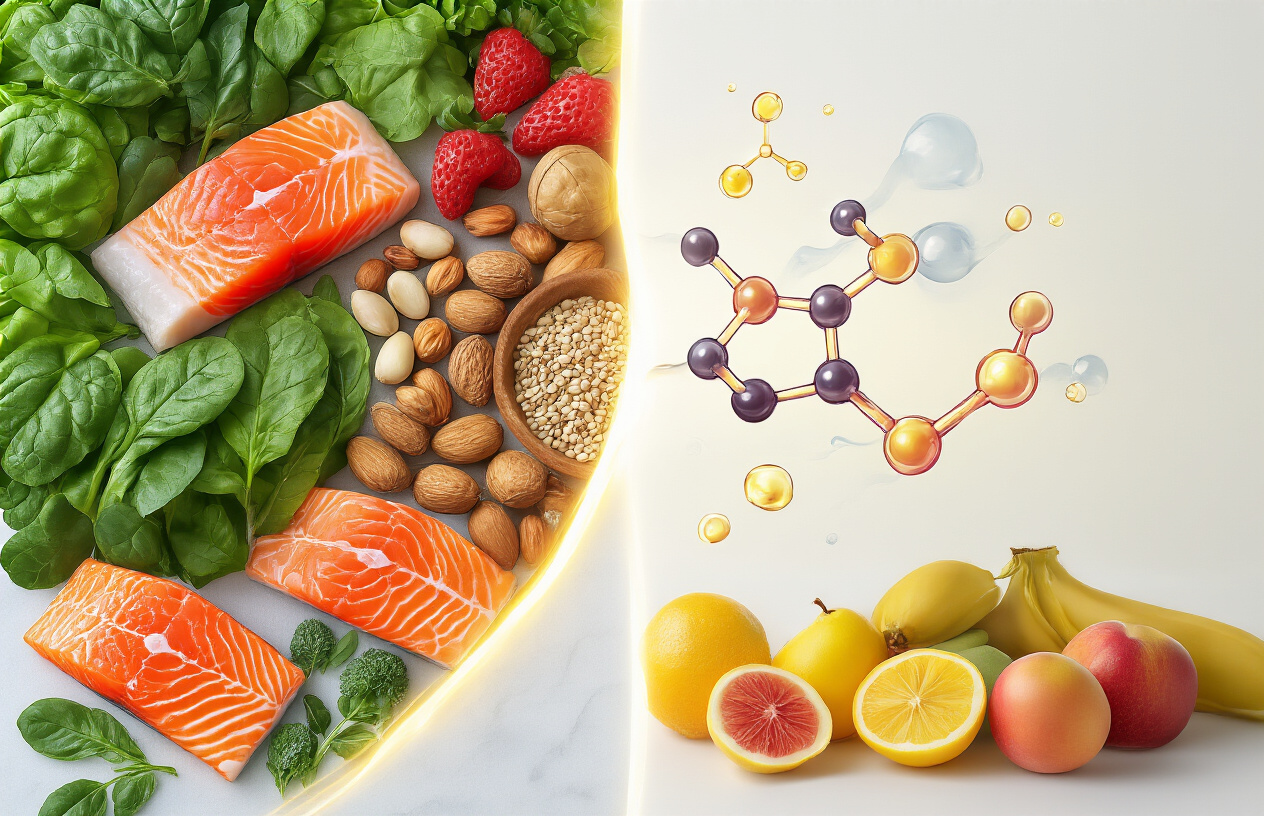
Key hormones that fluctuate during menstrual cycle
Your menstrual cycle involves a complex dance of hormones that rise and fall throughout the month. Estrogen starts low during your period, then climbs steadily until ovulation, creating that mid-cycle peak. After ovulation, progesterone takes center stage, rising dramatically before dropping sharply if pregnancy doesn’t occur.
These shifts don’t happen in isolation. Cortisol, your stress hormone, can spike during PMS week, making you feel overwhelmed and irritable. Insulin sensitivity changes too – many women notice they crave carbs more intensely during the luteal phase because their bodies process sugar differently. Serotonin, your feel-good neurotransmitter, dips when estrogen falls, which explains why you might feel moody or anxious before your period.
The thyroid hormones also fluctuate, affecting your metabolism and energy levels. This is why some women feel sluggish or notice their usual workout routine feels harder during certain weeks. Understanding these patterns helps you work with your body rather than against it.
How nutrient deficiencies worsen PMS symptoms
When your body lacks essential nutrients, those normal hormonal fluctuations become magnified problems. Magnesium deficiency is incredibly common and directly worsens cramps, headaches, and mood swings. Your muscles need magnesium to relax properly, so without enough, everything tightens up – including your uterus.
B vitamins, especially B6, play crucial roles in neurotransmitter production. When you’re running low, your brain can’t make enough serotonin and GABA, leaving you feeling anxious, depressed, or unable to handle stress. Vitamin D deficiency affects mood regulation and can intensify PMS depression.
Iron levels naturally drop during menstruation, but if you’re already deficient, you’ll experience extreme fatigue, brain fog, and irritability. Calcium works alongside magnesium for muscle function – without adequate amounts, cramping becomes more severe and sleep quality suffers.
| Nutrient | Common Deficiency Signs | PMS Impact |
|---|---|---|
| Magnesium | Muscle cramps, headaches | Severe cramping, migraines |
| Vitamin B6 | Mood swings, fatigue | Depression, irritability |
| Iron | Extreme tiredness, cold hands | Heavy bleeding, exhaustion |
| Calcium | Sleep problems, muscle tension | Intense cramps, anxiety |
The gut-hormone connection in menstrual health
Your gut produces and metabolizes hormones, making digestive health central to menstrual wellness. The gut microbiome contains an enzyme called beta-glucuronidase that can reactivate estrogen your liver has processed for elimination. When harmful bacteria overproduce this enzyme, estrogen gets recycled back into your system instead of being removed, creating estrogen dominance.
This excess estrogen worsens PMS symptoms like breast tenderness, mood swings, and heavy periods. A healthy gut lining also affects nutrient absorption – if inflammation damages your intestinal walls, you can’t properly absorb the vitamins and minerals needed for hormone balance.
Your gut bacteria actually produce neurotransmitters. About 90% of your serotonin is made in your digestive tract, not your brain. When your microbiome is imbalanced, serotonin production suffers, directly impacting your mood during PMS.
Stress hormones create a vicious cycle here. High cortisol damages gut lining and feeds harmful bacteria, while poor gut health triggers more inflammation and stress hormone release. This is why women with digestive issues like IBS often experience more severe PMS symptoms.
Supporting your gut with fiber-rich foods, fermented foods, and avoiding inflammatory triggers creates a foundation for better hormone balance throughout your cycle.
Essential Vitamins and Minerals That Reduce PMS Severity

Magnesium for muscle cramps and mood stabilization
Magnesium works like a natural muscle relaxer, making it particularly effective for women dealing with painful cramps during PMS. This essential mineral helps regulate muscle contractions by blocking calcium from entering muscle cells, which reduces the intensity of uterine cramping. Many women find that taking 200-400mg of magnesium daily during the two weeks before menstruation significantly reduces both the frequency and severity of cramps.
Beyond physical relief, magnesium plays a crucial role in stabilizing mood fluctuations. The mineral supports healthy neurotransmitter function, particularly GABA production, which promotes feelings of calm and relaxation. Women with adequate magnesium levels report less irritability, anxiety, and mood swings during their premenstrual phase.
The best food sources include dark leafy greens, nuts, seeds, whole grains, and dark chocolate. Magnesium glycinate tends to be the most easily absorbed form for supplementation, causing fewer digestive issues than other types.
Vitamin B6 for hormonal regulation and bloating relief
Vitamin B6 acts as a cofactor in over 100 enzyme reactions, many of which directly influence hormone metabolism. This vitamin helps the liver process and eliminate excess estrogen, which can accumulate during the luteal phase and contribute to PMS symptoms. Research shows that women taking 50-100mg of B6 daily experience significant reductions in breast tenderness, bloating, and mood-related symptoms.
B6 also supports the production of serotonin and dopamine, two neurotransmitters that regulate mood and sleep patterns. This explains why adequate B6 levels help combat the depression and irritability common during PMS.
For bloating specifically, B6 acts as a natural diuretic by helping the kidneys regulate sodium and fluid balance. This reduces water retention that causes uncomfortable swelling and that “puffy” feeling many women experience before their period.
Excellent food sources include salmon, tuna, chickpeas, potatoes, and bananas. Taking B6 with other B vitamins enhances absorption and effectiveness.
Calcium and Vitamin D for emotional balance
The calcium-vitamin D partnership proves especially powerful for managing emotional PMS symptoms. Calcium deficiency correlates strongly with increased anxiety, depression, and irritability during the premenstrual phase. Studies show that women consuming 1,000-1,200mg of calcium daily report up to 50% fewer mood-related PMS symptoms.
Calcium helps regulate nerve transmission and muscle function, including the smooth muscles in blood vessels and the uterus. Adequate levels prevent the dramatic calcium fluctuations that can trigger mood swings and physical discomfort.
Vitamin D enhances calcium absorption while independently supporting mood regulation through its effects on serotonin synthesis. Many women with severe PMS have vitamin D deficiency, and correcting this deficiency often dramatically improves symptoms. Aim for 1,000-2,000 IU daily, especially during winter months when sun exposure is limited.
Dairy products, fortified plant milks, sardines, and leafy greens provide calcium, while fatty fish, egg yolks, and fortified foods supply vitamin D.
Iron for energy and fatigue prevention
Iron deficiency affects up to 20% of menstruating women and significantly worsens PMS fatigue. During menstruation, iron stores become depleted due to blood loss, but the fatigue often begins during the premenstrual phase when iron levels start dropping.
Iron is essential for oxygen transport throughout the body. Without adequate iron, cells can’t produce energy efficiently, leading to the crushing fatigue many women experience before their period. This fatigue often comes with brain fog, difficulty concentrating, and feeling overwhelmed by daily tasks.
Women need 18mg of iron daily during their reproductive years. Focus on heme iron from animal sources like lean beef, poultry, and fish, which absorbs more easily than non-heme iron from plant sources. When eating plant-based iron sources like spinach, lentils, and quinoa, pair them with vitamin C-rich foods like citrus fruits or bell peppers to enhance absorption.
Avoid taking iron supplements with coffee, tea, or dairy products, as these can inhibit absorption.
Omega-3 fatty acids for inflammation reduction
Omega-3 fatty acids, particularly EPA and DHA, directly combat the inflammatory processes that drive many PMS symptoms. These healthy fats help produce anti-inflammatory prostaglandins while reducing the production of inflammatory compounds that worsen cramping, breast tenderness, and mood symptoms.
Research consistently shows that women with higher omega-3 intake experience less severe PMS symptoms across all categories – physical, emotional, and behavioral. The anti-inflammatory effects are particularly noticeable for reducing cramping intensity and duration.
Omega-3s also support brain health by maintaining cell membrane fluidity and promoting healthy neurotransmitter function. This helps stabilize mood and reduce the anxiety and depression that often accompany PMS.
Fatty fish like salmon, mackerel, and sardines provide the most bioavailable forms. Plant sources include walnuts, flaxseeds, and chia seeds, though these require conversion to the active forms EPA and DHA. Most women benefit from 1,000-2,000mg of combined EPA and DHA daily, either through food or high-quality fish oil supplements.
Anti-Inflammatory Foods That Combat PMS Discomfort

Leafy Greens and Cruciferous Vegetables for Hormone Detox
Your liver works overtime during your menstrual cycle, breaking down excess hormones and preparing them for elimination. Leafy greens like spinach, kale, and arugula contain compounds that support this natural detox process. These vegetables are packed with folate, which helps your body methylate hormones properly, making them easier to clear from your system.
Cruciferous vegetables deserve special attention for PMS relief. Broccoli, Brussels sprouts, cauliflower, and cabbage contain indole-3-carbinol, a compound that converts to diindolylmethane (DIM) in your digestive system. DIM helps metabolize estrogen into its less problematic forms, potentially reducing estrogen dominance that contributes to breast tenderness, mood swings, and water retention.
Try adding a handful of baby spinach to your morning smoothie or roasting Brussels sprouts with garlic for dinner. Even frozen vegetables work well – they retain most of their nutritional value and are convenient when fresh options aren’t available.
Fatty Fish and Plant-Based Omega-3 Sources
Omega-3 fatty acids act as natural anti-inflammatory agents in your body, directly countering the inflammatory processes that worsen PMS symptoms. Salmon, mackerel, sardines, and anchovies provide EPA and DHA, the most bioactive forms of omega-3s that your body can use immediately.
If you don’t eat fish, plant-based sources offer alpha-linolenic acid (ALA), which your body converts to EPA and DHA, though less efficiently. Flaxseeds, chia seeds, hemp hearts, and walnuts are excellent options. Ground flaxseed works better than whole seeds because your body can actually digest and absorb the nutrients.
Research shows women who consume adequate omega-3s experience less cramping, reduced breast tenderness, and more stable moods during their cycle. Aim for two servings of fatty fish per week or include plant-based omega-3 sources daily. A tablespoon of ground flaxseed in your oatmeal or a handful of walnuts as a snack can make a real difference.
Antioxidant-Rich Berries and Colorful Vegetables
The vibrant colors in fruits and vegetables signal high antioxidant content, which helps combat oxidative stress that peaks during menstruation. Blueberries, blackberries, cherries, and pomegranates contain anthocyanins – powerful compounds that reduce inflammation and may help ease menstrual pain.
Bell peppers, sweet potatoes, carrots, and tomatoes provide different antioxidant profiles. Red and orange vegetables are rich in carotenoids, while purple foods contain resveratrol and other protective compounds. This variety ensures you’re getting a broad spectrum of anti-inflammatory benefits.
Berries also contain natural sugars that can help satisfy cravings without causing the blood sugar spikes that worsen PMS symptoms. Fresh berries work great, but frozen versions are just as nutritious and often more budget-friendly. Try mixing berries into yogurt, adding them to salads, or blending them into smoothies.
Whole Grains for Sustained Energy and Mood Stability
Refined carbohydrates cause blood sugar roller coasters that can intensify PMS mood swings, fatigue, and cravings. Whole grains provide steady energy release, helping maintain stable blood sugar levels throughout the day. Quinoa, brown rice, oats, and barley contain fiber that slows glucose absorption and keeps you feeling satisfied longer.
Whole grains also supply B vitamins, particularly B6, which plays a role in neurotransmitter production. Adequate B6 levels support serotonin synthesis, potentially improving mood and reducing depression-like symptoms common during PMS.
Steel-cut oats make an excellent breakfast base – top with berries and nuts for a PMS-fighting meal. Quinoa works well in salads or as a rice substitute, while whole grain bread can satisfy carb cravings without the crash that comes from white bread.
Foods to Avoid During Your Menstrual Cycle

Refined Sugars That Trigger Mood Swings
Sugar might seem like the perfect comfort food when PMS hits, but it’s actually making your symptoms worse. When you eat refined sugars like candy, pastries, or sugary drinks, your blood sugar shoots up quickly, triggering a rapid insulin response. This rollercoaster effect leaves you crashing hard within hours, amplifying mood swings, irritability, and fatigue that are already challenging during PMS.
The problem goes deeper than just energy crashes. Refined sugar consumption increases inflammation in your body and disrupts your gut microbiome, which plays a crucial role in hormone production and regulation. Your gut bacteria help metabolize estrogen, so when sugar throws off this delicate balance, it can worsen PMS symptoms across the board.
Common refined sugar sources to watch out for:
- Sodas and energy drinks
- Processed breakfast cereals
- Store-bought muffins and cookies
- Candy and chocolate bars
- Flavored yogurts with added sugars
- Condiments like ketchup and barbecue sauce
Instead of reaching for that donut when cravings hit, try naturally sweet alternatives like fresh berries, dates stuffed with almond butter, or dark chocolate with at least 70% cacao content.
Excess Caffeine That Worsens Anxiety and Breast Tenderness
Your morning coffee habit might need a temporary adjustment during PMS week. While moderate caffeine intake (about 200mg daily) is generally fine, excess caffeine can amplify anxiety, nervousness, and jittery feelings that many women already experience before their period. Caffeine blocks adenosine receptors in your brain, keeping you wired when your body actually needs more rest during this phase of your cycle.
Breast tenderness, one of the most uncomfortable PMS symptoms, can become significantly worse with high caffeine intake. Caffeine stimulates your adrenal glands and can increase cortisol production, which interferes with your body’s natural hormone balance. This hormonal disruption often translates to more painful, swollen breasts.
Caffeine sources to monitor:
- Coffee (95mg per 8oz cup)
- Black tea (47mg per 8oz cup)
- Energy drinks (50-300mg per serving)
- Dark chocolate (12mg per ounce)
- Some pain medications contain caffeine
Consider switching to herbal teas like chamomile or peppermint during PMS week. If you can’t give up coffee entirely, limit yourself to one cup in the morning and avoid afternoon caffeine completely.
High-Sodium Foods That Increase Bloating
Salt makes everything taste better, but during PMS, it’s working against you. High sodium intake causes your body to retain water, leading to that uncomfortable bloated feeling that makes your clothes feel tight and leaves you feeling sluggish. The hormonal changes during PMS already make you more prone to water retention, so adding extra salt to the mix creates a perfect storm for bloating.
Your kidneys work overtime to balance sodium levels, and when they can’t keep up, the excess sodium pulls water into your tissues. This shows up as puffiness in your face, hands, and abdomen – exactly what you don’t want when you’re already dealing with PMS discomfort.
High-sodium foods to limit:
- Processed meats (deli turkey, bacon, sausage)
- Canned soups and broths
- Restaurant meals and takeout
- Frozen dinners
- Pickled foods
- Salted snacks like chips and pretzels
- Cheese and processed dairy products
Read nutrition labels carefully – aim to stay under 2,300mg of sodium per day during PMS week, and ideally closer to 1,500mg if you’re particularly sensitive to bloating.
Processed Foods That Disrupt Hormonal Balance
Processed foods are loaded with additives, preservatives, and artificial ingredients that can throw your hormones out of whack right when you need them most balanced. These foods often contain trans fats, high fructose corn syrup, and chemical preservatives that your liver has to work extra hard to process. Since your liver is also responsible for metabolizing hormones like estrogen, overloading it with processed food toxins can worsen PMS symptoms.
Many processed foods also contain endocrine disruptors – chemicals that mimic or interfere with your body’s hormones. These substances can make your PMS symptoms more severe and longer-lasting. Packaged foods are also typically low in the nutrients your body needs most during menstruation, like magnesium, B vitamins, and healthy fats.
Processed foods to avoid:
- Fast food meals
- Packaged snack foods
- Frozen pizzas and heat-and-eat meals
- Processed breakfast items
- Artificial sweeteners and diet products
- Packaged baked goods with long ingredient lists
Focus on whole, unprocessed foods during PMS week. Shop the perimeter of the grocery store where fresh produce, lean proteins, and dairy are located, and skip the middle aisles filled with processed options.
Meal Timing and Eating Patterns for PMS Relief
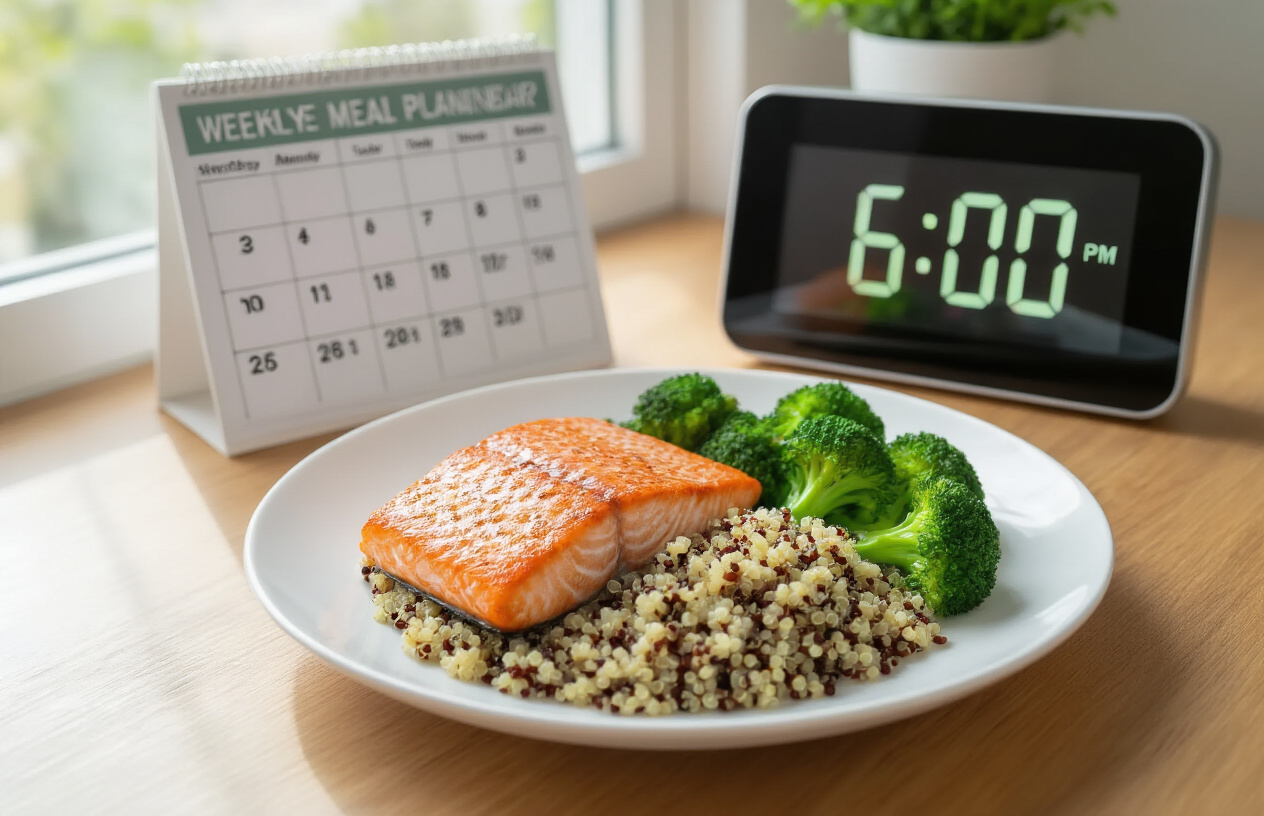
Frequent Small Meals to Stabilize Blood Sugar
Blood sugar fluctuations play a major role in PMS symptoms like irritability, mood swings, and cravings. When your blood glucose levels spike and crash throughout the day, your body releases stress hormones like cortisol, which can worsen PMS symptoms and throw your reproductive hormones out of balance.
Eating smaller, balanced meals every 3-4 hours helps maintain steady blood sugar levels. This approach prevents the dramatic dips that trigger intense sugar cravings and emotional rollercoasters. Each mini-meal should combine complex carbohydrates, lean protein, and healthy fats to slow glucose absorption and provide sustained energy.
Sample meal timing schedule:
- 7:00 AM – Breakfast
- 10:00 AM – Mid-morning snack
- 1:00 PM – Lunch
- 4:00 PM – Afternoon snack
- 7:00 PM – Dinner
- 9:30 PM – Light evening snack (if needed)
Focus on balanced combinations like apple slices with almond butter, Greek yogurt with berries and nuts, or whole grain crackers with hummus. These combinations provide protein to stabilize blood sugar while satisfying cravings in a healthy way.
Pre-Menstrual Phase Nutrition Strategies
The luteal phase (approximately 14 days before menstruation) requires specific nutritional adjustments to support your changing hormonal landscape. During this time, progesterone levels rise, which can increase appetite and cravings while slowing digestion.
Key nutritional focuses during the pre-menstrual phase:
- Increase complex carbohydrates: Your brain needs more glucose during this phase to support serotonin production. Choose quinoa, sweet potatoes, oats, and brown rice over simple sugars
- Boost magnesium intake: This mineral helps relax muscles and reduce cramping. Include dark leafy greens, pumpkin seeds, and dark chocolate (70% cacao or higher)
- Add more fiber: Combat progesterone-related digestive sluggishness with 25-35 grams of fiber daily from vegetables, fruits, and whole grains
- Include healthy fats: Omega-3 fatty acids from salmon, walnuts, and flaxseeds help reduce inflammation and support mood stability
Timing considerations:
- Eat your largest meals earlier in the day when digestion is most efficient
- Have your last substantial meal 3 hours before bedtime to improve sleep quality
- Include a small protein-rich snack before bed to prevent middle-of-the-night blood sugar drops
Hydration Guidelines for Reducing Water Retention
Water retention during PMS might seem counterintuitive, but proper hydration actually helps reduce bloating and puffiness. When you’re dehydrated, your body holds onto every drop of water it can get, leading to uncomfortable swelling.
Daily hydration targets:
- Drink 8-10 glasses of water throughout the day
- Start each morning with 16-20 ounces of water to kickstart your metabolism
- Sip water consistently rather than chugging large amounts at once
Strategic hydration timing:
- Drink a glass of water 30 minutes before each meal to aid digestion
- Reduce intake 2 hours before bedtime to minimize sleep disruption
- Increase intake during exercise or hot weather
Natural diuretic foods to include:
- Cucumber, celery, and watermelon contain natural compounds that help eliminate excess fluid
- Herbal teas like dandelion, nettle, and green tea provide gentle diuretic effects
- Lemon water helps support kidney function and reduces bloating
What to limit:
- Excess sodium from processed foods, which promotes water retention
- Caffeine after 2 PM, as it can interfere with sleep and increase cortisol
- Alcohol, which dehydrates the body and disrupts hormone balance
Pay attention to your urine color as a hydration indicator – pale yellow suggests proper hydration, while dark yellow indicates you need more fluids.
Targeted Supplement Protocols for Severe PMS
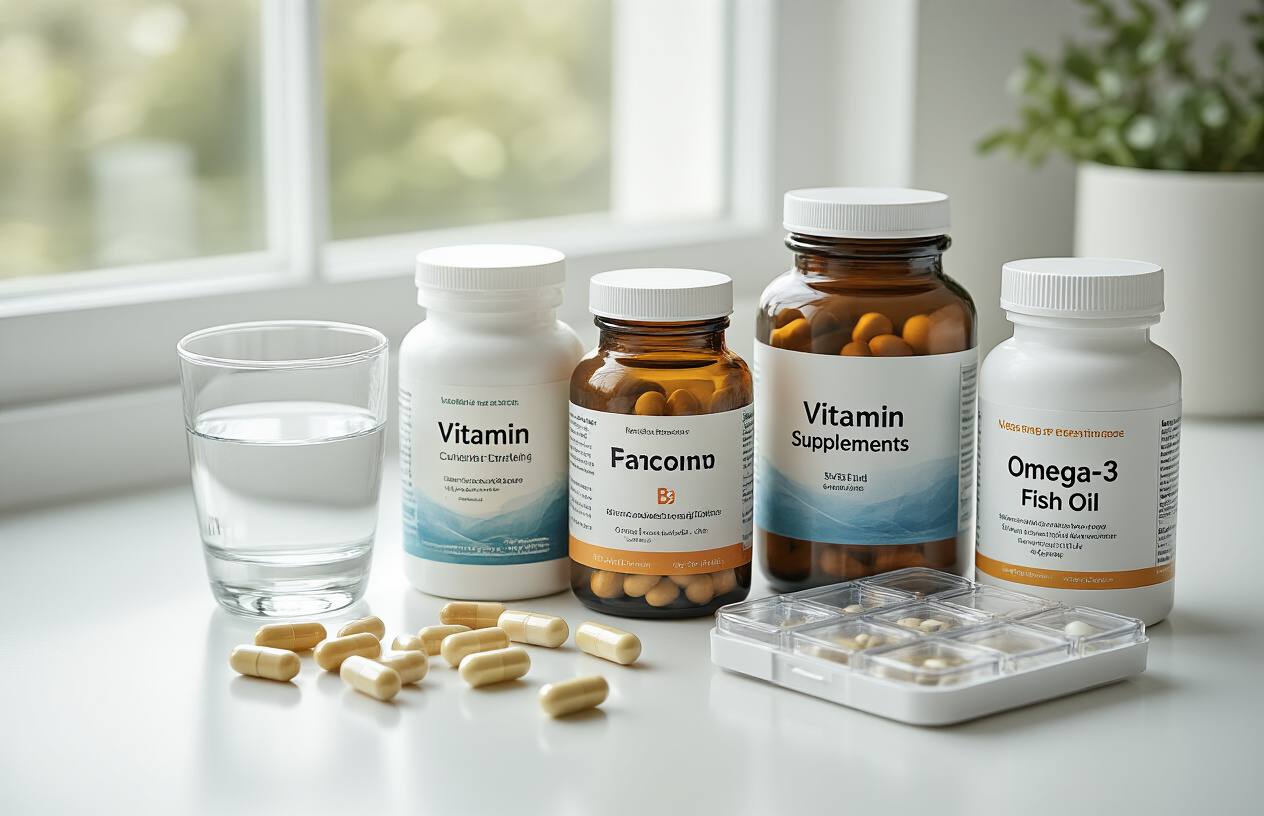
Evidence-based dosage recommendations
When PMS symptoms become severe and dietary changes aren’t providing enough relief, specific supplements can make a significant difference. Research shows that certain nutrients work best within targeted dosage ranges.
Magnesium stands out as one of the most effective supplements for PMS relief. Studies consistently show that 200-400mg daily of magnesium glycinate or citrate can reduce cramping, mood swings, and water retention. Start with 200mg and gradually increase if needed.
Vitamin B6 helps regulate hormones and neurotransmitters that affect mood and physical symptoms. The optimal dose ranges from 50-100mg daily, taken as pyridoxine or the more bioavailable P-5-P form. Higher doses can cause nerve damage, so staying within this range is crucial.
Calcium supplementation at 1000-1200mg daily has shown remarkable results in clinical trials, reducing PMS symptoms by up to 50% in some women. Calcium carbonate with meals or calcium citrate on an empty stomach both work well.
Evening primrose oil provides gamma-linolenic acid (GLA), which helps balance prostaglandins. Research supports taking 1000-3000mg daily, typically divided into two doses. Look for supplements standardized to contain 8-10% GLA.
Chasteberry (Vitex) has been used for centuries to support hormonal balance. Clinical studies show that 20-40mg of standardized extract daily can significantly reduce breast tenderness, mood changes, and irregular cycles.
Best timing for supplement intake
Timing your supplements correctly can dramatically improve their effectiveness and reduce potential side effects. Most PMS supplements work best when taken consistently throughout the entire menstrual cycle, not just during symptom periods.
Morning supplements include B6 and chasteberry, which can boost energy and mood. Take these with breakfast to avoid any potential stomach upset and to align with your body’s natural hormone production cycles.
Evening supplements work particularly well for magnesium and calcium, as these minerals promote relaxation and better sleep quality. Take magnesium 1-2 hours before bedtime, and calcium can be taken with dinner or as a bedtime snack.
Split dosing works best for higher amounts of calcium and evening primrose oil. Divide your daily dose into two portions – morning and evening – to maintain steady blood levels and improve absorption.
Cycle timing matters for some supplements. Start chasteberry on day 1 of your cycle for best results. Evening primrose oil can be taken continuously, but some women find it most effective when started 10 days before their expected period.
Potential interactions and safety considerations
Understanding supplement interactions and safety concerns helps you avoid problems while maximizing benefits. Some combinations work synergistically, while others can interfere with medications or cause side effects.
Drug interactions require careful attention. Magnesium can reduce the absorption of antibiotics and certain medications, so space them at least 2 hours apart. Calcium interferes with iron absorption, so take iron supplements separately. B6 can interact with certain seizure medications and should be discussed with your doctor if you take prescription drugs.
Supplement combinations generally work well together, but moderation is key. Taking magnesium with calcium improves absorption of both minerals. However, too much calcium can interfere with magnesium absorption, so maintain a 1:1 or 2:1 ratio (calcium to magnesium).
Side effects are usually mild but worth monitoring. High doses of magnesium can cause digestive upset or loose stools – start low and increase gradually. B6 over 100mg daily can cause tingling in hands and feet. Evening primrose oil occasionally causes headaches or nausea in sensitive individuals.
Quality matters significantly with supplements. Choose third-party tested products from reputable manufacturers. Look for USP or NSF certification when available. Avoid supplements with unnecessary fillers, artificial colors, or potential allergens that might trigger additional symptoms.
Always consult with a healthcare provider before starting any supplement protocol, especially if you have underlying health conditions or take prescription medications.
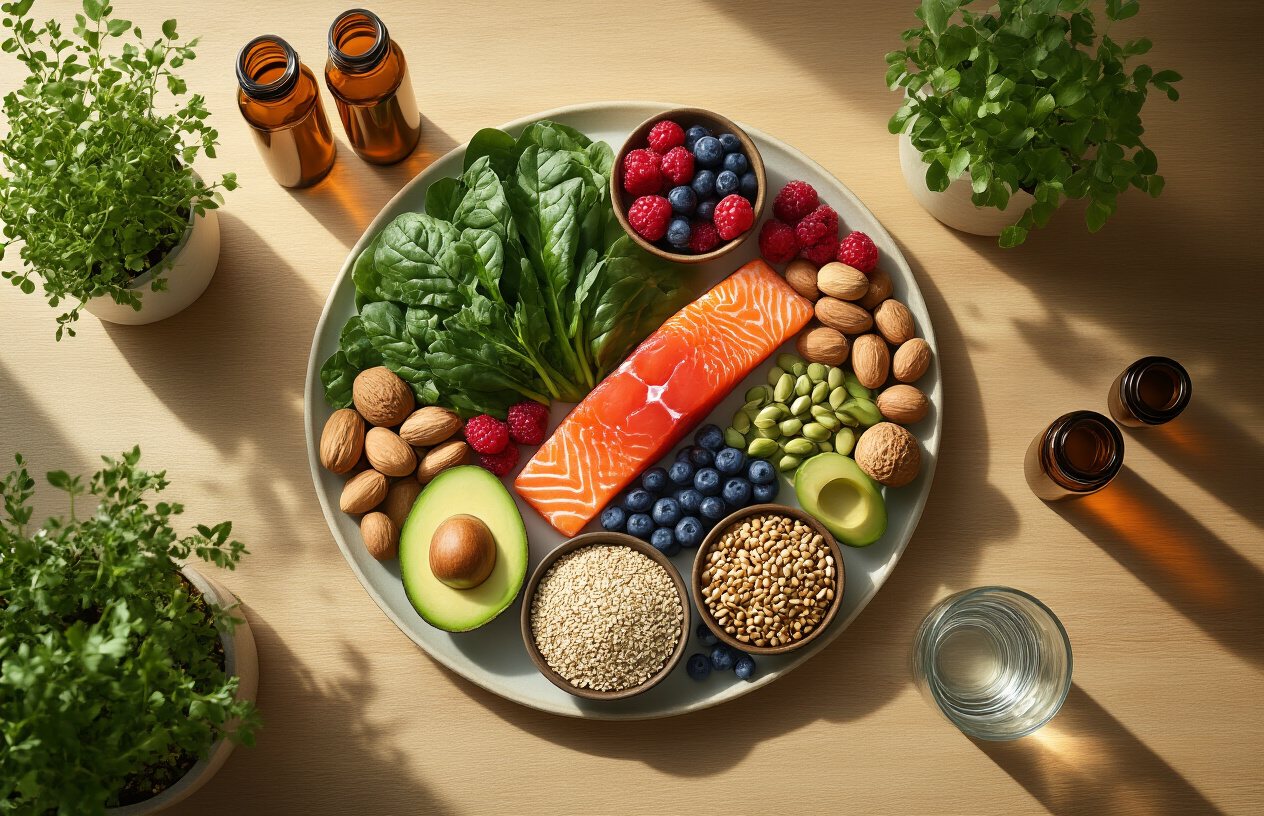
The foods you eat play a bigger role in managing PMS symptoms than you might think. By focusing on nutrient-rich options like leafy greens for magnesium, fatty fish for omega-3s, and colorful fruits packed with antioxidants, you can naturally support your hormonal balance and reduce monthly discomfort. Avoiding processed foods, excess caffeine, and refined sugars while timing your meals consistently creates an even stronger foundation for symptom relief.
Start small by adding one or two anti-inflammatory foods to your daily routine this week, and pay attention to how your body responds. If your PMS symptoms are severe, consider working with a healthcare provider to explore targeted supplements alongside these dietary changes. Your monthly cycle doesn’t have to derail your life – the right nutritional approach can help you feel more balanced, energized, and in control throughout every phase of your cycle.




